Why BBQ Ribs Taste Better At A Restaurant Than At Home
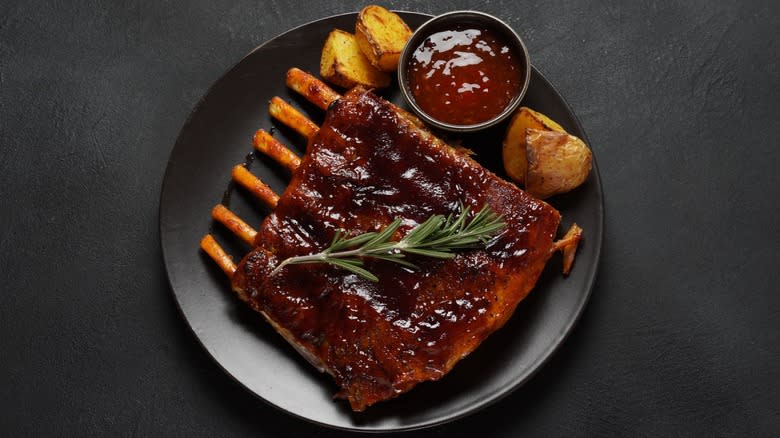
BBQ ribs are one of those foods that just taste better when someone else makes them. A good BBQ takes a huge amount of knowledge and experience to nail -- and although you can make barbecued ribs in the comfort of your own home, they often taste so much better when you get them in a restaurant. Since they're a cut of meat that can so easily become tough, dry, and chewy, placing your trust in the seasoned hands of a professional can allow you to avoid an unpleasant dining experience, and let you savor the combo of perfectly-cooked meat, balanced seasoning rubs, and a well-made sweet-savory glaze.
BBQ experts can be notorious for keeping their cards close to their chest and not revealing their secrets. Luckily, we managed to find a few that generously shared some key tips and advice on how to avoid those mistakes we all make at home. For this article, we spoke to Harry Miller, Houston Livestock Show and Rodeo director and Jr. Cook-Off subcommittee member, and Joonas Jokiniemi, chef, BBQ expert and founder of BBQ blog Grill Smoke Love. Miller and Jokiniemi gave us an extraordinary amount of tips on how to smoke ribs properly, the best ways to ensure that your meat is as flavorful as can be, and those all-important secret ingredients.
Read more: The 13 Best Steaks For Grilling
In Restaurants, The Cuts Are Carefully Selected
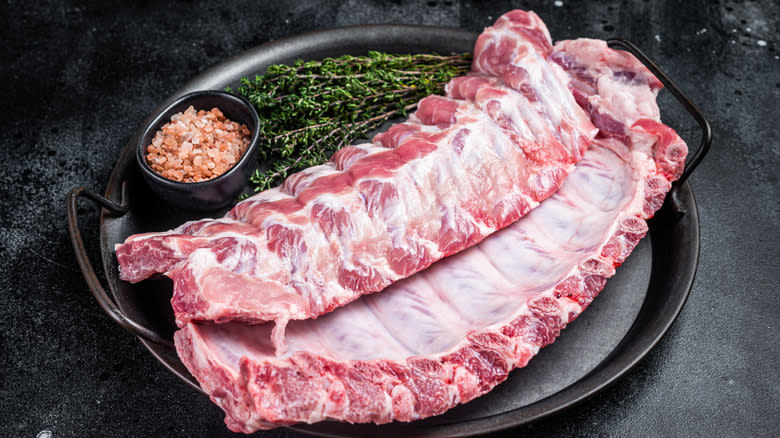
The best BBQ ribs start with a premium cut of meat, and knowing which type of ribs to go for is crucial. According to Harry Miller, if you're opting for pork ribs, you have several different choices. "The three most common types of ribs cooked are baby back ribs, spareribs (full rack) and St. Louis style ribs," he says. "They all have a great flavor when prepared and cooked properly." You can't go wrong with these ribs, but it's a good idea to think about how you're going to serve them. Miller points out that baby back ribs may be better-suited for an appetizer due to their smaller size, while the other kinds may be more appropriate for your entrée.
However, it's good to keep in mind that you don't have to go for pork ribs at all, and Jokiniemi suggests getting your ribs from an entirely different animal. "For BBQ, the most flavorful cut is often considered to be the beef short ribs. The short ribs are meatier and more marbled compared to other ribs like spare ribs or baby back ribs from pork." At the end of the day, your preference will boil down to your taste -- but it's important to procure the best-quality, freshest meat you can from a source you trust.
Restaurant Chefs Allow Their Rub To Meld With The Ribs
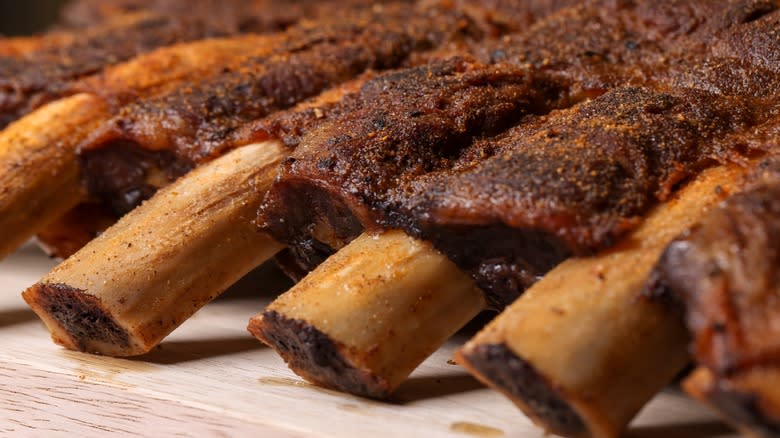
Some of the biggest mistakes that happen when cooking ribs involve the dry rub. A dry rub has several functions: First off, it imbues your ribs with huge amounts of flavor, which then permeates into the meat as it cooks. It also helps them absorb the smoky notes from the burner more effectively, and gives them a better texture.
Applying your rub, however, isn't as simple as just slapping it on just before you cook them. "Any good cook will tell you they allow their ribs to sit refrigerated overnight so the ribs and the rub become one with each other," says Harry Miller. The more time your ribs have to sit with the rub, the more they'll be affected by it, gaining extra flavor and a better texture and not just falling off the outside. What's also important is how you apply your rub, and Miller encourages you not to be shy. "You have to show the ribs a lot of love when you season them," he stresses. "It's called rib rub for a reason. Don't shake it on... Rub it in!"
Restaurant Ribs Are Cooked Low And Slow

You can't rush ribs -- and yet, so many people try. Something about cooking them at home encourages people to think that they can cook their ribs more quickly than you might in a restaurant, and expect the same result. This is something that both Harry Miller and Joonas Jokiniemi would never recommend. "Many BBQ restaurants now have a fully automated pit similar to an Old Hickory or a Southern Pride pit," says Miller. "These work by controlling the exact heat and time the ribs cook. The normal time is between two and a half and three hours."
Jokiniemi says that sometimes, ribs can take even longer, and may be cooked for up to six hours in restaurants. "The exact time depends on the type and cut of the rib," he states. "Beef ribs usually require a longer cooking time than pork ribs due to their larger size and thicker meat." Jokiniemi points out that the most important thing is to remember that ribs take a huge amount of time for their collagen to break down and become juicy and tender. If you don't let them do that, you'll be left with a pretty tough meal.
BBQ Ribs Are Often Smoked In Restaurants
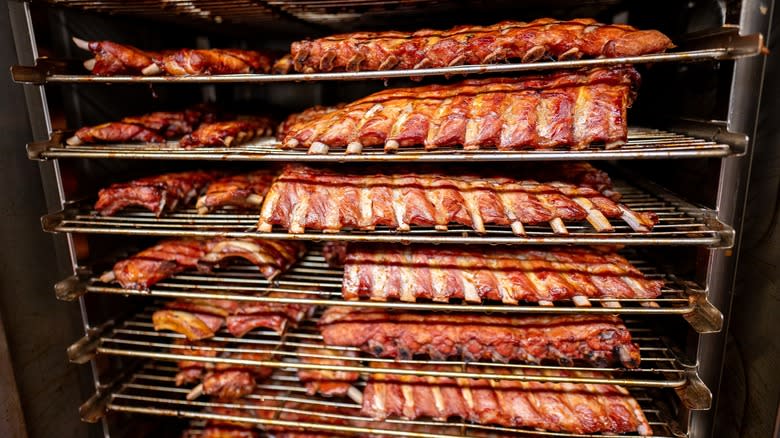
Why are restaurant ribs so much better than homemade ones? They harness the power of smoke. This crucial ingredient is so often missing from a home set-up, which are more commonly cooked in the oven, but it makes all the difference. Smoking your ribs imbues them with complex, deep, woody flavors that offset the sweetness of the rib glaze and the fatty meat. It also helps them develop that deep-brown char on their outside, giving them a piece of food you eat with your eyes as much as your mouth.
Restaurants can use either a cold or warm smoking process to cook their ribs. These are undertaken in commercial smoker cabinets or grills for up to 16 hours. This ultra-long process ensures that the smoky flavors get to the very core of the meat and give every single bite maximum amounts of taste. This approach requires some chefs to get up at the crack of dawn to start their ribs, with some starting as early as 4:00 a.m. Take a bite of slow-smoked ribs, though, and you can taste the work and love that went into them.
Restaurant Chefs Are Careful Not To Overcook Their Meat

Anyone who's ever cooked meat will know how delicate a process it can be, and rib cuts may be the most temperamental of all. There's an assumption that the longer you cook ribs, the better they'll be, thanks to them developing additional tenderness and sliding off the bone in your mouth -- but according to Harry Miller, this is something restaurant chefs never do. Ribs are not supposed to fall off the bone," says Miller. "Nothing is worse than grabbing a rib bone and lifting it... But no rib meat comes along for the ride to Tasterville! It's just annoying. That is what you get when they are overdone."
Instead, you should avoid the temptation to keep your ribs in for too long. While this cut does need a good amount of time to cook, blasting it for too long will leave your meat overly loose. "A rib should come to your mouth intact and leave your bite mark along the edge of the rib when you eat," Miller states. "The rest of the meat needs to stay on the bone."
Some Restaurants Brine Their Ribs
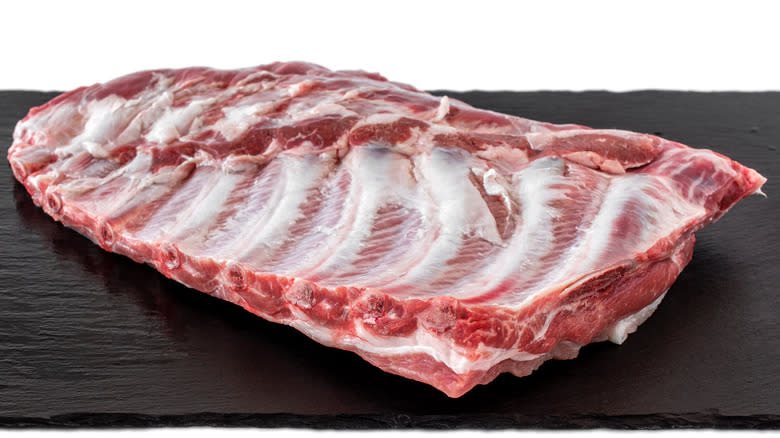
Opinions vary on brining meat pretty considerably. While some people swear by it as a way to give meat additional tenderness, others have been scarred for doing it too long and reducing their food to mush. When it comes to ribs, though, restaurants are more likely to brine them, thanks to their ability to impart extra flavor. "Some cooks do brine their ribs in a saltwater and spice mixture for a period of time," says Harry Miller. "If you have a really good rib rub, it will reduce to a bit of a slurry after it has been on the ribs for a while and that in and of itself is a marinade to a degree."
You can also marinade your ribs if you wish, but you need to be careful. Marinades generally have an acidic component in them which helps to tenderize the meat, but leaving it for too long can ruin its texture and leave it stringy and mealy. Try to limit your marination to a maximum of six hours, although you can get a good result in less time -- even as little as 10 minutes will help boost your ribs' flavor.
In BBQ Restaurants, Chefs Know To Lay The Rub On Thick
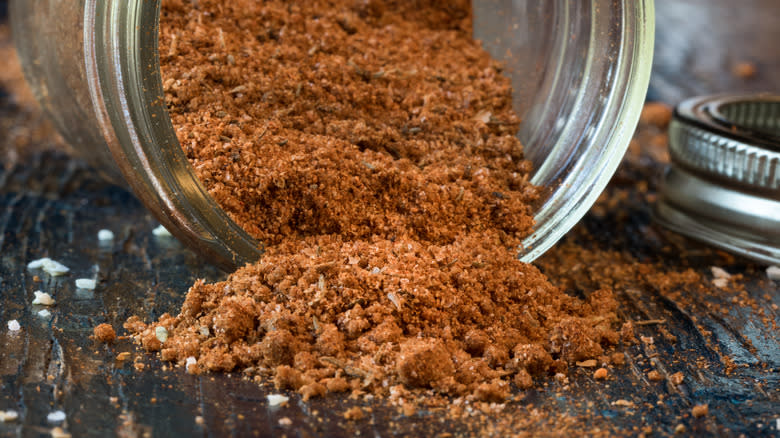
One thing that BBQ chefs don't do by halves is flavor. To get the biggest, boldest taste for their ribs, they know that they have to go large on every component -- including their rub. It's the amount of rub you use, as opposed to specific ingredients, that makes all the difference, according to Harry Miller. "Most ingredients in a rib rub are far from being the one elusive "secret" ingredient. The real secret is how much of each that you use and how thick you apply it."
Thinking that a mere sprinkle on the outside will do is somewhere that home chefs go badly wrong. You should massage your ribs with the rub until every inch of meat is fully covered, with any excess falling off. It's a good idea to make more rub than you think you'll need, to avoid running out halfway through. As for the ingredients you need, Miller says that they're pretty standard. "The most common ingredients in most rubs are salt and pepper, smoked paprika, garlic, and onion powder, either Cayenne or black pepper, and brown sugar. If one exists, brown sugar might be a solid candidate for the secret ingredient."
Home Chefs Often Forget To Remove The Membrane
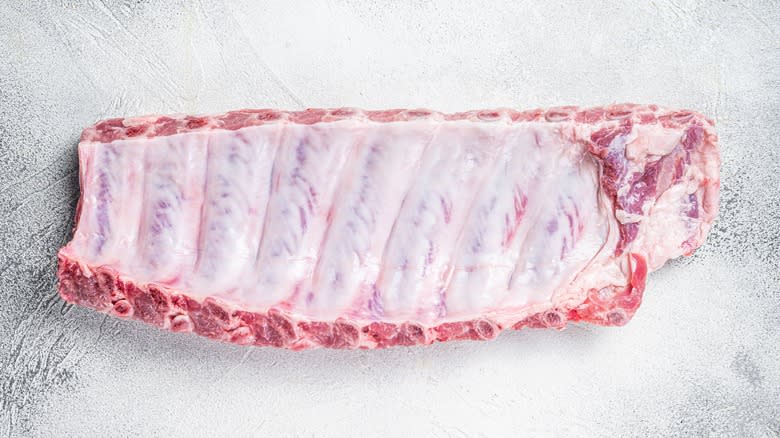
One thing stands between you and beautiful-tasting ribs, and it's something you might not expect. The underside of ribs usually comes with a thick white layer of tissue attached to it, known as the membrane. This membrane remains tough even when you cook it, no matter how long it's heated for. Failing to remove it can also limit how your ribs taste, says Joonas Jokiniemi, who also notes that keeping the membrane on "can prevent seasonings and smoke from penetrating the meat effectively."
Restaurant chefs know how annoying the membrane can be, and so in commercial kitchens removing it is one of the first things they do. If you've never done this before, there's a knife tip that will help you remove your membrane with virtually no effort. All you need is a butter knife, or another knife that has a blunt, round edge. Slip your knife under the membrane and then pull it up slightly, loosening it. The membrane should then be easy enough to pull off the rest of the ribs in one easy motion. Avoid using a sharp knife here, as doing so can puncture the membrane and make it harder to remove in one piece.
Restaurants Know Exactly How To Balance The Glaze's Flavors
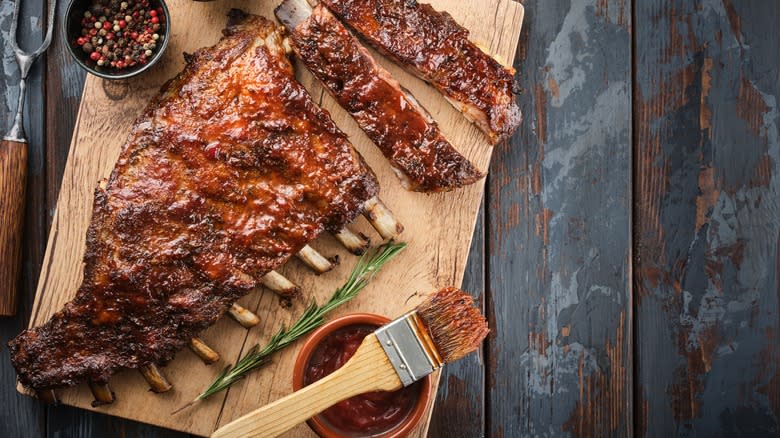
You can cook the perfect rack of ribs, but let's be real: Unless it's covered in a sticky-sweet, gently caramelized glaze, it'll barely be worth eating. The balance of flavors in your glaze makes all the difference, and restaurant chefs have got their ingredients down to a science, and understand that you need to bring various different tastes to the table. "A perfect glaze for BBQ ribs usually contains up to 5 components: Sweetness, acidity, umami, spices, and heat," says Joonas Jokiniemi. "This combination creates a rich, balanced coating that caramelizes beautifully on the ribs during cooking."
These flavors can come from various different sources, but for the authentic BBQ experience, Jokiniemi recommends keeping it to a few choice options. For sweetness, brown sugar, honey, or molasses add more depth and caramelized notes than regular white sugar. Lemon or lime juice or apple cider vinegar provide bright acidic notes, while umami can be obtained best through Worcestershire sauce or soy sauce. For your spices, paprika, black pepper and garlic powder are a safe choice, while cayenne pepper and hot sauce can bring the fire. No matter what ingredients you opt for, though, make sure that you don't overdo it on a single flavor element.
In Restaurants, They Never Let The Heat Flare Up
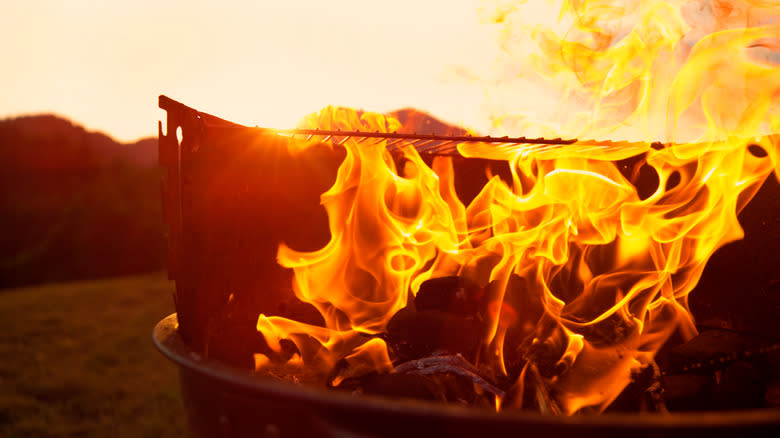
The classic image of barbecue cooking generally involves sizzling pieces of meat over a roaring flame. When it comes to ribs, though, that fiery heat is the last thing you want. One of the most common mistakes that home chefs make when making ribs in their backyard is "cooking at too high a temperature or letting the fire get away from you by walking away from the pit," says Harry Miller. While this might seem like a rookie mistake, this is easily done, especially if you don't have your temperature control system in check or aren't used to the pit you're using.
Allowing this to happen will ruin your ribs. "High heat can cause the outside of the ribs to burn before the inside is properly cooked," says Joonas Jokiniemi. It's important to remember that it's not just the meat that will burn and char: The rub you've put on the outside of it will also blacken, leaving you with seriously unpleasant acrid notes. Instead, try to control the temperature of your pit or grill at around 225 degrees Fahrenheit. It's always a good idea to grab yourself a barbecue thermometer if you don't have one, even if your grill has temperature settings.
Some Chefs Use Secret Ingredients
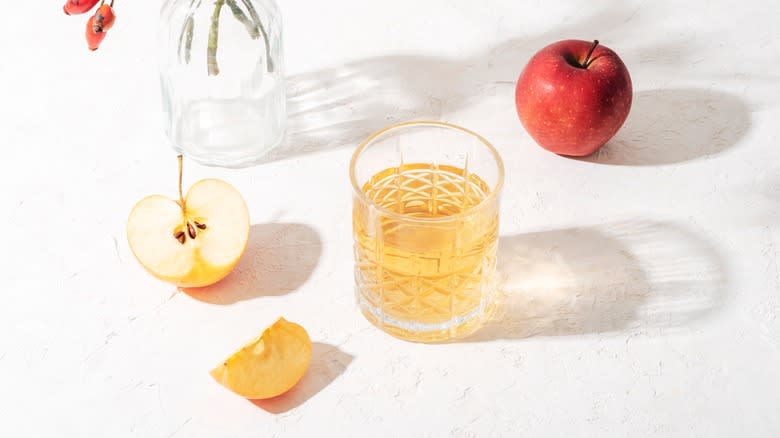
The fabled "secret ingredient" in recipes is, in our opinion, secondary to good cooking technique. Unless you have the fundamentals down, your food will never be as good as it can be, no matter what you're throwing into it. Having said this, with ribs there are a few sneaky ingredients that can help them get to the next level. One of these, Joonas Jokiniemi says, is "apple juice, for spritzing the ribs while cooking to keep them moist and add a subtle sweetness." Put some apple juice in a spray bottle and douse them periodically while they cook to brighten their flavor. It's also a great addition to your glaze, where it can provide a floral note.
Alcohol, specifically beer, is also a secret ingredient. "Beer is sometimes used in the marinade or mopping sauce for its tenderizing properties and depth of flavor," Jokiniemi says. Whiskey can also give some oaky notes to your glaze and deepen its smoky notes. You don't have to add too much, and don't worry about the alcohol content either: It'll cook off once they've sat on the grill for a little while.
BBQ Chefs Know That Resting Their Meat After Cooking Is Crucial
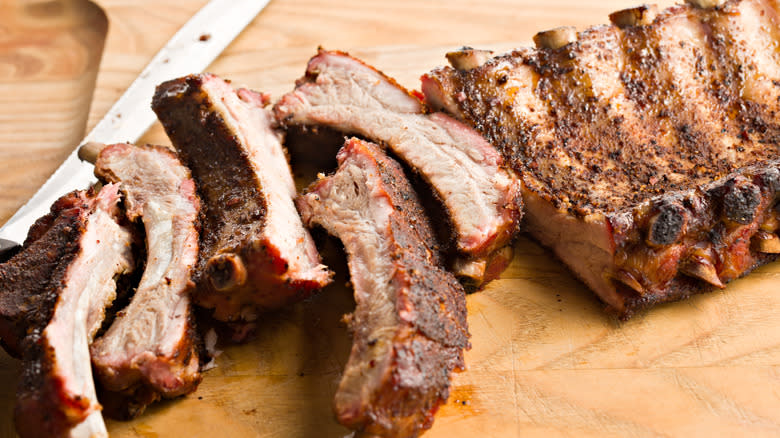
For some reason, people often skip over the resting process with ribs. Maybe it's because the meat is slightly thinner than other cuts like steak or brisket, or maybe it's because the syrupy glaze leads people to assume that it'll have enough moisture. However, "like most meats, ribs need to rest after cooking to allow the juices to redistribute," says Joonas Jokiniemi. The reason why you should always let your meat rest once it's cooked is because as it heats up, the proteins tighten and force the moisture to the outer edges. If you were to serve it straight away, all of those juices would spill everywhere, and you'd end up with tasteless ribs.
Letting them rest allows the proteins to loosen and the moisture to reincorporate with the meat. As a result, when you bite into them, they remain juicy and flavorful. You should always rest your ribs for at least 10-20 minutes, but as a general rule the thicker they are, the longer you have to rest them. If you're planning on resting them for longer, wrap them in some tin foil to keep them warm.
Restaurant Chefs Never Forget To Check The Internal Temperature
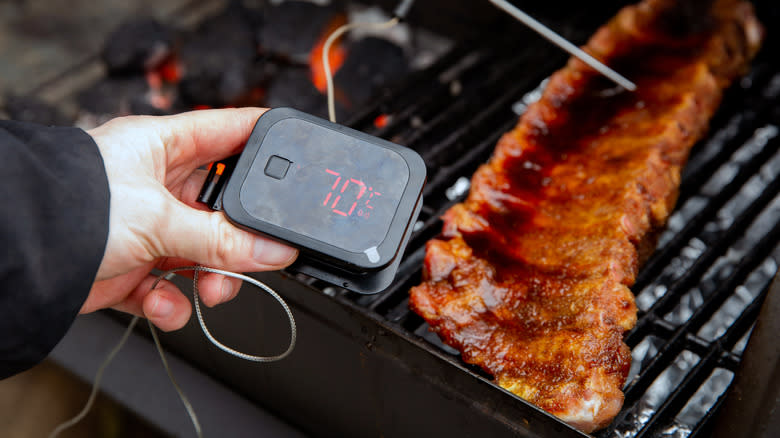
You should never assume that meat is fully cooked, and restaurant chefs are the first to take the guesswork out of things. In restaurants, it's common to make sure the internal temperature of ribs is right before serving them. Chefs will usually use a meat thermometer to do this, although more skilled pitmasters will be able to tell whether their ribs are cooked by feeling them (we'd recommend you avoid doing this, though, unless you're an expert).
You shouldn't underestimate how important internal temperature is. "It's crucial to cook ribs to the right internal temperature for safety and quality," says Joonas Jokiniemi. "For pork, this is 145°F (63°C), but for a tender finish, many aim for around 190°F (88°C) to break down the connective tissues." To check your meat's internal temperature properly, make sure you're inserting your thermometer to the thickest part of your meat. Don't be too worried about where you place the probe, as any holes will be covered by the glaze. Avoid going too high above the safety temperature, as this can cause your meat to seize up and become tough.
Read the original article on The Daily Meal.


